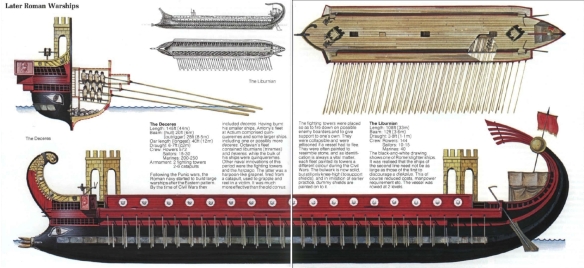
Between 190 and the build-up to Actium in the latter half of the 30s, warships larger than “sixes” disappeared from the fleets of the Mediterranean powers. Rome had methodically destroyed her major rivals at sea and emerged from the war with Antiochus as the undisputed naval power of the Mediterranean. One might reasonably ask why the Romans never developed an interest in midsized polyremes, except for their occasional use of “sixes” for flagships. The commonly accepted answer is derived from authors like Polybius and Livy, who chronicled the development of Roman naval power during the Punic Wars. The answer goes like this: the Romans perfected the art of grapple-and-board warfare in order to off set the nautical skill of their adversaries. Their first “fives” were of sturdy build, and although they did not handle as well as the Carthaginian “fives” they faced, they carried the Romans to victory thanks to a special boarding bridge called a “raven” (corax) with a spike on the outboard end that firmly gripped the deck of the attacked ship. The Romans soon dispensed with the cumbersome raven, but continued their preference for grappling their enemies-this time with iron hooks attached to ropes ( ferreae manus )-dragging them alongside so their marines could decide the battle. They so perfected the use of “fives” for this purpose that they did not need or want to build larger ships. When faced with larger ships in battle, they simply grappled them and let their marines do the rest. During the first century, they sometimes employed naval artillery to soften up their enemies from a distance before closing with them, throwing grapnels, and letting their marines finish them off. By this means, for example, Octavian defeated Antony’s larger vessels at Actium.
Distortions stemming from preserved battle narratives that focus on the experiences of the marines. A similar view emerges from the recent study of the Roman navy (up to 167 BCE) by Christa Steinby. She demonstrates convincingly how our sources routinely minimize the nautical expertise of Roman naval personnel and downplay the full measure of the navy’s effectiveness. A more defensible answer to our question (i. e., why the Romans avoided midsized polyremes) will be found in the strategic objectives they built their naval forces to achieve.
We should start with the most obvious reason, namely, that the Romans avoided the desire to build bigger and bigger warships because their primary enemies lacked effective naval siege units populated by midsized polyremes. These enemies included, first and foremost, the Carthaginians, but also the Sicilians, the Macedonians, the Syrians, and the Egyptians. As a result, the Romans were not driven, like the enemies of Demetrius, to compete in this arena to achieve their foreign policy objectives. When they began to build a fleet of any size, we see from Polybius that they matched the Carthaginians’ largest vessels, i. e., their “fives,” and worked to achieve naval dominance with this class. During the course of the first Punic War, they built hundreds of “fives,” and when these were lost in storms or in battle, they resolutely built hundreds more, making sure to surpass their enemy in numbers of units.
During the decade of the 240s, we might have expected Rome, with Syracusan help, to develop a naval siege unit as they struggled to gain control of Drepanum and Lilybaeum in western Sicily (250-41), but they chose not to do so. It seems that the Roman ruling class was simply unwilling to assume the staggering costs such a navy would require on an annually recurring basis. The demands asked of them were already high; in 243, for example, the wealthiest Romans were asked to loan the capital required to prepare a fleet of 200 “fives” (Polyb. 1.59.6-8), which eventually won them the war. Prior to their victory over the Carthaginians at the Aegates Islands in 241, they also lacked the naval superiority required to safeguard a siege unit from attack and insure their unhindered application of force against the besieged Corinthian garrisons.
In general, the strength of Roman naval power depended upon the superior manpower and timber reserves of the Italian peninsula. Drawing from these considerable resources, the Romans produced fleets that achieved naval dominance over their enemies and allowed them to transport superior land forces to the region of conflict. They then counted on their armies to defeat their enemies, rather than relying on city-by-city campaigns waged with military transports and naval siege units. They did indeed wage some campaigns against individual cities such as Lilybaeum, but their overall preference in their major wars seems to have been to establish naval dominance over the seas between Italy and the area of conflict, and then import a land force from Italy. For example, when fighting Antiochus III in the Syrian War (192-88), the Romans transported an army to Apollonia in Illyria and then marched it through Greece to Asia Minor for the crucial battle at Magnesia in Lydia that resulted in peace.
Their naval battles principally resulted from attempts to intercept enemy supplies and reinforcements before they came to specific land bases, generally outside the confines of a harbor. Quite simply, in this kind of warfare, medium-sized polyremes were a liability rather than an asset. There are a few exceptions during the Second Punic War when Roman commanders developed skills in naval siege warfare, but they never felt the need to build midsized polyremes, that is, until the Actian campaign of Antony and Cleopatra almost two centuries later. In order to appreciate the reasons behind Antony’s construction of multiple ships in the range of “sixes” to “tens,” we should first review the Roman accomplishments in naval siege warfare that occurred during the third century. Two main episodes document their learning curve and are thus worth examining in detail.